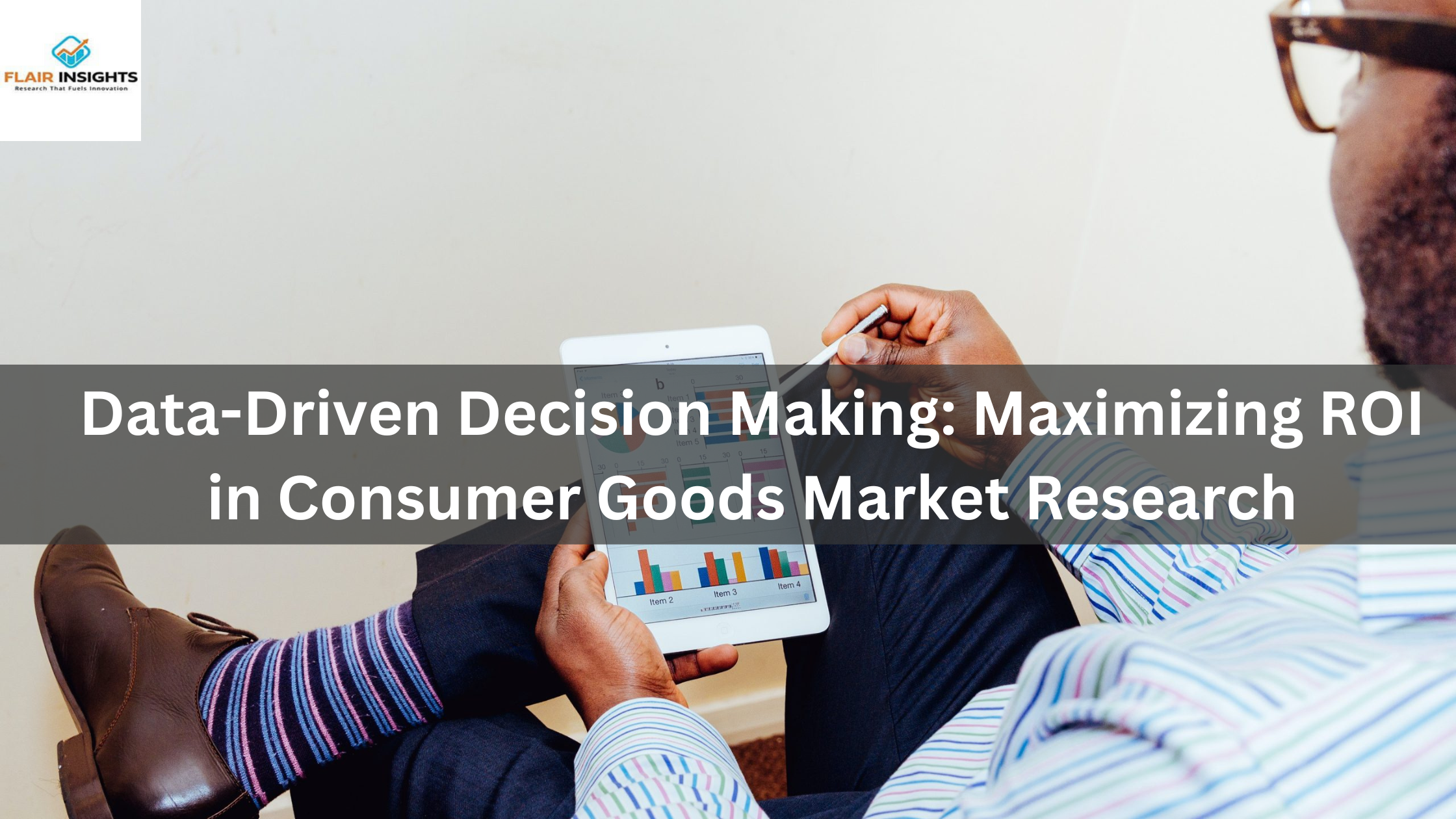
The problems and opportunities facing a consumer products company are enormous in today's fast moving, changing business market. One of the critical drivers of success is making an informed judgment upon the availability of reliable data. "Knowledge is power, the saying goes, and there is no area where this could be more accurate than in the field of consumer products market research. The importance of data-driven decision-making in improving return on investment in the consumer goods industry is what this article will be about.
I. The Evolution of Market Research:
Historically companies manufacturing consumer goods have used traditional tools of market research, like surveys, focus groups, and trend analysis. These undoubtedly provided substantial insights into consumer preference and behavior but were nonetheless bound by small samples, subjectivity, and time consumption most of the time. It is in market research that technology and big data have really transformed how companies collect and analyze huge amounts of data in real-time.
II. The Impact of Big Data on Consumer Goods:
Big data transformed consumer goods firms by giving them a treasure trove of information that would have otherwise been very expensive and cumbersome to collect, process and analyze in order to make strategic decisions. Big data represents an all rounded view of the market landscape: from social media analytics to online sales data and ultimately, supply chain information. Companies can create competitive advantages for themselves by using advanced analytics and machine learning algorithms in the quest to find patterns, trends, and correlations that would have otherwise remained elusive to distinguish.
III. Personalisation and Customer Segmentation:
Information driven choices have one of the most compelling advantages in the ability to personalize offerings and offering structure, as per the taste of each customer. With detailed client profiling and audience segmentation, companies will be able to manage their marketing campaigns, suggest products, and pricing to their specific client categories. This raises both customer experience and brand stickiness.
IV. Inventory Management and Supply Chain Efficiency:
Inventory management and a lean supply chain are the cornerstones of success for any consumer goods company. A data-driven approach is required in terms of inventory optimization and supply chain efficiency. By analyzing their past sales data, demand forecasts, and the performance of their suppliers, companies can make informed decisions on how much inventory to stock at various stages of the supply chain, avoid stockouts, and reduce excess inventory. This increases operational efficiency and decreases costs significantly.
V. Competitive Intelligence and Pricing Strategies:
Pricing tactics can make or break a product in the fiercely competitive consumer products market. Companies, considering various factors like market demand, rival pricing, and willingness to pay by consumers, will be able to optimally set their prices with data driven decision making. In this respect, firms faced with dynamic market conditions can adopt real-time modifications of the pricing tactics and thereby remain really nimble and adapt very fast in light of changes in customer behavior or the competitive environment. This could further give scope to the company to position their products in the market strategically so as to capture maximum profit by exploiting the competitive knowledge produced from data analysis.
VI. Marketing Effectiveness and Campaign Optimization:
Consumer goods marketing has evolved from the classic model of advertising to a multichannel, digitally driven process. Enterprises are enabled with data driven decisions to measure the true effectiveness of any marketing campaign. Tracking KPIs such as conversion rates, customer acquisition costs, and ROAS enables companies to adjust marketing strategies in the most real-time manner. This ensures every dollar of marketing budget impacts the most effective channels and campaigns.
VII. Risk Mitigation and Decision Confidence:
In today's volatile business environment, risks that consumer goods companies have to face range from changing consumer preferences to worldwide disruptions of supply chains. Data driven decision-making acts to mitigate these risks by giving the companies real time insight into market trends and possible difficulties. With a solid grasp of the situation in the market, companies are able to act proactively to reduce the effect of unforeseen events and increase overall decision confidence.
VIII. Customer Feedback and Product Innovation:
Customer feedback is a goldmine of valuable information for consumer goods companies. Now, with the advent of social media and online customer reviews expressing opinions and preferences in real time, it is even going data driven to enable companies to systematically check out this feedback for the indication of areas where improvements and innovations can be made. This is how they turn customer sentiment into business products in line with changing demand to stay ahead in market trends. Thereby, this cyclic approach to product development improves customer satisfaction and builds a culture of sustained innovation.
IX. Sustainability and Corporate Social Responsibility (CSR):
In recent years, consumers have become more sensitive to the environmental and social implications of what they buy. Quantitative decision-making allows consumer goods companies to take their strategies into a market that is oriented toward sustainability and CSR. Insight capture from data related to consumer preferences for eco friendly products, ethical sourcing, and sustainable practices would have enabled the organization to make relevant decisions that empower the socially aware consumer. This will in turn create positive brand perception and enable the entry into new markets within a growing segment of environmentally sensitive consumers.
X. Adapting to Market Trends and Global Dynamics:
Consumer product companies prepare their business across such a diverse force as a global marketplace, it is subject to the maximum forces of geopolitics and culture, apart from the common macroeconomic forces. This allows these organizations to adopt strategies and operational practices as needed for fast-tracking trends toward globalization. Regular tracking of changes in macroeconomic indicators, geopolitical impacts, and cultural churnings helps a company be abreast of changes in consumer behavior and realign strategies. This ensures that companies in the consumer goods sector are readily positioned against optimizing their return on investment with the best-possible opportunities arising in the fast-changing global scenario.
Conclusion
In this journey of coping with the complexities of today's business environment, data driven decision making is not a choice but a must for consumer goods companies. That will really be the difference among entities in maximizing ROI through what big data can do to market research, personalization, inventory optimization, and pricing strategies down to marketing effectiveness. A consumer goods company can keep ahead of competition, meet evolving consumer expectations, and remain confident of long-term growth by continuing to make informed decisions, supported by information from data insights within the dynamically changing marketplace.
Trending Posts

Global Silver Nanoparticles Market
The global silver nanoparticles market was valued at $2.08 billion in 2020, and is projected to reach $4.1 billion by 2027, growing at a CAGR of ~17%

The Basic Pension Comes - Federal Cabinet Decides On the Pension Supplement
Financial security in old age is an issue that is causing stomach pains for more and more people in Germany. Low-wage earners fear the elderly. The ba

The Future of Artificial Intelligence
In recent years, the field of artificial intelligence (AI) has witnessed unprecedented growth and transformative advancements. As AI technologies

"LNG Bunkering" Here is something you must know!
In the current scenario of growing pollution, companies are trying to adapt more and more sustainable approach that not only gives eco-friendly result

Sailing into the future with Autonomous Ships
Autonomous Vehicles (AVs) are the uproar of this era. After airways, thanks to the companies like Tesla, that people are now getting used to see drive

Rising Demand For Uninterrupted Power Supply Is Expected To Drive The Power Rental Market
Todays world is totally reliant on electric power. There are many things which are not manageable without electricity. Power rental is a concept where

Rapidly growing IT industry coupled with the trend of bringing your own device (BYOD) is expected to provide new opportunities for growth of Cloud Collaboration
Cloud collaboration is the process of sharing and co-authoring the computer-based work through cloud technology

Fact check on UV Disinfection for COVID-19
Many regulatory authorities and bodies believe that UV disinfection technologies can play a role in a multiple barrier approach to reducing the transm

Vaccination: Vaccination Against Measles is Now Mandatory in Germany
The subject of compulsory vaccination has always heated peoples minds and caused emotionally charged discussions. The latest law in this area - the ob

The Global Ventilator Market Grows at a CAGR of 7.75 %
The Global Ventilator Market, which was at $688 million in the year 2016, is about to double by the year 2025, and reach a value of $1,347 million. Th
Recent Posts

Tariffs & Trade: Key Trends, Policies, and Market Impact
A tariff is a tax imposed by a government on imported or exported goods. It is primarily used to regulate international trade by either encouraging domestic production or generating revenue for the government.

The Global Buy Now Pay Later (BNPL) Market: Growth and Opportunities
The global Buy Now Pay Later (BNPL) market has emerged as a revolutionary financial solution, transforming how consumers approach shopping and payments. Offering flexibility and convenience, BNPL allows consumers to make purchases and pay.

Global Motorhome Market: Growth and Forecast
The motorhome market has gained significant momentum over the past decade, driven by rising interest in outdoor tourism, evolving consumer lifestyles, and advancements in vehicle design and technology. As a preferred option for travelers seeking.

The Global Poppy Seed Market: Growth and Trends
Poppy seeds, derived from the opium poppy plant (Papaver somniferum), have been a vital component in global culinary, pharmaceutical, and personal care industries for centuries. The global poppy seed market is gaining traction due to its versatility.

Global Plant Breeding and CRISPR Plants Market
The global food industry is facing immense pressure due to rising population levels, diminishing arable land, and the impact of climate change. Innovations in plant breeding, particularly the use of CRISPR technology, are reshaping the agricultural .

Global Pheromones Market – Trends, Opportunities, and Forecast
The global pheromones market has witnessed significant growth, primarily driven by the rising demand for eco-friendly pest control solutions in agriculture. Pheromones, natural chemicals emitted by insects and other organisms to communicate.

The Role of Technology in Oil and Gas Risk Management
In an industry as dynamic and complex as oil and gas, risk management is crucial for ensuring operational efficiency, regulatory compliance, and safety. Risk management software has become an indispensable tool for companies in this sector.

Global Smart Grid Sensors Market
The global energy landscape is undergoing a significant transformation, with smart grid technologies at the forefront. Smart grid sensors, a critical component of modern energy grids, enable efficient monitoring, energy distribution.

Global Photovoltaic Glass Market Research Report
The global photovoltaic (PV) glass market is experiencing unprecedented growth, driven by the accelerating shift towards renewable energy and the integration of sustainable materials in construction. This report delves into the market’s key growth.

Exploring the Growth of the Global Micro Solar Inverter Market
The Global Micro Solar Inverter Market is forecasted to expand significantly, growing from an estimated value of USD 4.8 billion in 2024 to USD 14.6 billion by 2030, with a CAGR of 24.2%. This growth reflects increased adoption of solar energy system
.png)